Tianle Zhang
To Align or Not to Align: Strategic Multimodal Representation Alignment for Optimal Performance
Nov 19, 2025Abstract:Multimodal learning often relies on aligning representations across modalities to enable effective information integration, an approach traditionally assumed to be universally beneficial. However, prior research has primarily taken an observational approach, examining naturally occurring alignment in multimodal data and exploring its correlation with model performance, without systematically studying the direct effects of explicitly enforced alignment between representations of different modalities. In this work, we investigate how explicit alignment influences both model performance and representation alignment under different modality-specific information structures. Specifically, we introduce a controllable contrastive learning module that enables precise manipulation of alignment strength during training, allowing us to explore when explicit alignment improves or hinders performance. Our results on synthetic and real datasets under different data characteristics show that the impact of explicit alignment on the performance of unimodal models is related to the characteristics of the data: the optimal level of alignment depends on the amount of redundancy between the different modalities. We identify an optimal alignment strength that balances modality-specific signals and shared redundancy in the mixed information distributions. This work provides practical guidance on when and how explicit alignment should be applied to achieve optimal unimodal encoder performance.
Safe Semantics, Unsafe Interpretations: Tackling Implicit Reasoning Safety in Large Vision-Language Models
Aug 12, 2025Abstract:Large Vision-Language Models face growing safety challenges with multimodal inputs. This paper introduces the concept of Implicit Reasoning Safety, a vulnerability in LVLMs. Benign combined inputs trigger unsafe LVLM outputs due to flawed or hidden reasoning. To showcase this, we developed Safe Semantics, Unsafe Interpretations, the first dataset for this critical issue. Our demonstrations show that even simple In-Context Learning with SSUI significantly mitigates these implicit multimodal threats, underscoring the urgent need to improve cross-modal implicit reasoning.
Navigating the Black Box: Leveraging LLMs for Effective Text-Level Graph Injection Attacks
Jun 16, 2025



Abstract:Text-attributed graphs (TAGs) integrate textual data with graph structures, providing valuable insights in applications such as social network analysis and recommendation systems. Graph Neural Networks (GNNs) effectively capture both topological structure and textual information in TAGs but are vulnerable to adversarial attacks. Existing graph injection attack (GIA) methods assume that attackers can directly manipulate the embedding layer, producing non-explainable node embeddings. Furthermore, the effectiveness of these attacks often relies on surrogate models with high training costs. Thus, this paper introduces ATAG-LLM, a novel black-box GIA framework tailored for TAGs. Our approach leverages large language models (LLMs) to generate interpretable text-level node attributes directly, ensuring attacks remain feasible in real-world scenarios. We design strategies for LLM prompting that balance exploration and reliability to guide text generation, and propose a similarity assessment method to evaluate attack text effectiveness in disrupting graph homophily. This method efficiently perturbs the target node with minimal training costs in a strict black-box setting, ensuring a text-level graph injection attack for TAGs. Experiments on real-world TAG datasets validate the superior performance of ATAG-LLM compared to state-of-the-art embedding-level and text-level attack methods.
LLM-Driven E-Commerce Marketing Content Optimization: Balancing Creativity and Conversion
May 27, 2025Abstract:As e-commerce competition intensifies, balancing creative content with conversion effectiveness becomes critical. Leveraging LLMs' language generation capabilities, we propose a framework that integrates prompt engineering, multi-objective fine-tuning, and post-processing to generate marketing copy that is both engaging and conversion-driven. Our fine-tuning method combines sentiment adjustment, diversity enhancement, and CTA embedding. Through offline evaluations and online A/B tests across categories, our approach achieves a 12.5 % increase in CTR and an 8.3 % increase in CVR while maintaining content novelty. This provides a practical solution for automated copy generation and suggests paths for future multimodal, real-time personalization.
Object-Focus Actor for Data-efficient Robot Generalization Dexterous Manipulation
May 21, 2025Abstract:Robot manipulation learning from human demonstrations offers a rapid means to acquire skills but often lacks generalization across diverse scenes and object placements. This limitation hinders real-world applications, particularly in complex tasks requiring dexterous manipulation. Vision-Language-Action (VLA) paradigm leverages large-scale data to enhance generalization. However, due to data scarcity, VLA's performance remains limited. In this work, we introduce Object-Focus Actor (OFA), a novel, data-efficient approach for generalized dexterous manipulation. OFA exploits the consistent end trajectories observed in dexterous manipulation tasks, allowing for efficient policy training. Our method employs a hierarchical pipeline: object perception and pose estimation, pre-manipulation pose arrival and OFA policy execution. This process ensures that the manipulation is focused and efficient, even in varied backgrounds and positional layout. Comprehensive real-world experiments across seven tasks demonstrate that OFA significantly outperforms baseline methods in both positional and background generalization tests. Notably, OFA achieves robust performance with only 10 demonstrations, highlighting its data efficiency.
RDI: An adversarial robustness evaluation metric for deep neural networks based on sample clustering features
Apr 16, 2025Abstract:Deep neural networks (DNNs) are highly susceptible to adversarial samples, raising concerns about their reliability in safety-critical tasks. Currently, methods of evaluating adversarial robustness are primarily categorized into attack-based and certified robustness evaluation approaches. The former not only relies on specific attack algorithms but also is highly time-consuming, while the latter due to its analytical nature, is typically difficult to implement for large and complex models. A few studies evaluate model robustness based on the model's decision boundary, but they suffer from low evaluation accuracy. To address the aforementioned issues, we propose a novel adversarial robustness evaluation metric, Robustness Difference Index (RDI), which is based on sample clustering features. RDI draws inspiration from clustering evaluation by analyzing the intra-class and inter-class distances of feature vectors separated by the decision boundary to quantify model robustness. It is attack-independent and has high computational efficiency. Experiments show that, RDI demonstrates a stronger correlation with the gold-standard adversarial robustness metric of attack success rate (ASR). The average computation time of RDI is only 1/30 of the evaluation method based on the PGD attack. Our open-source code is available at: https://anonymous.4open.science/r/RDI-B1DA.
Dexterous Hand Manipulation via Efficient Imitation-Bootstrapped Online Reinforcement Learning
Mar 06, 2025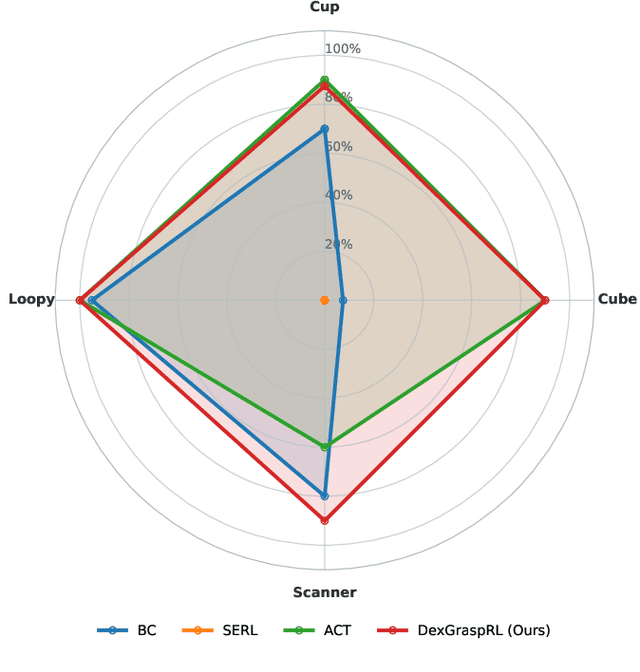
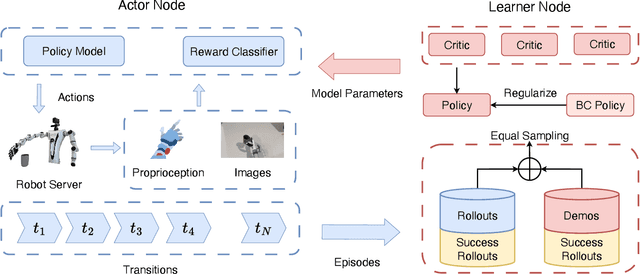
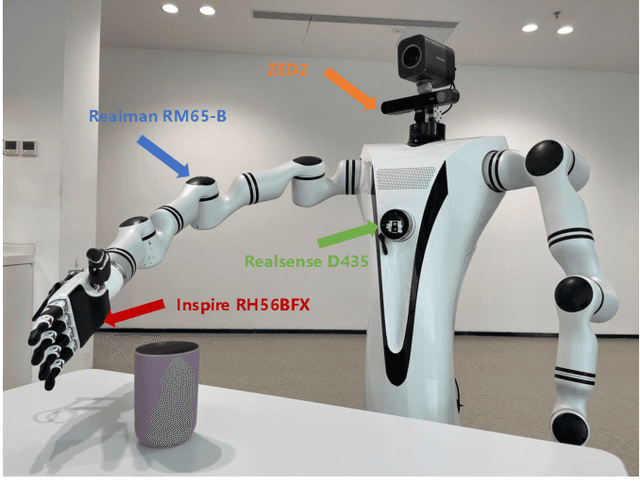
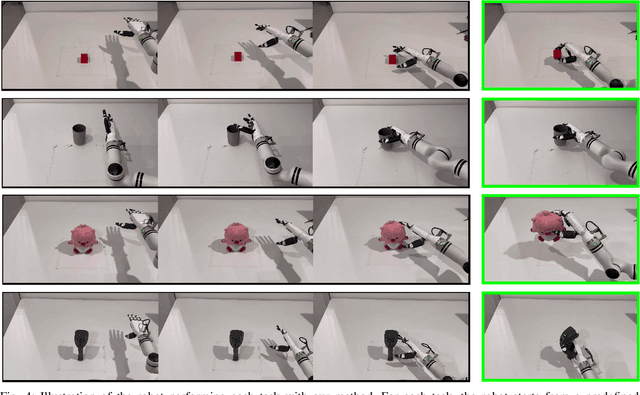
Abstract:Dexterous hand manipulation in real-world scenarios presents considerable challenges due to its demands for both dexterity and precision. While imitation learning approaches have thoroughly examined these challenges, they still require a significant number of expert demonstrations and are limited by a constrained performance upper bound. In this paper, we propose a novel and efficient Imitation-Bootstrapped Online Reinforcement Learning (IBORL) method tailored for robotic dexterous hand manipulation in real-world environments. Specifically, we pretrain the policy using a limited set of expert demonstrations and subsequently finetune this policy through direct reinforcement learning in the real world. To address the catastrophic forgetting issues that arise from the distribution shift between expert demonstrations and real-world environments, we design a regularization term that balances the exploration of novel behaviors with the preservation of the pretrained policy. Our experiments with real-world tasks demonstrate that our method significantly outperforms existing approaches, achieving an almost 100% success rate and a 23% improvement in cycle time. Furthermore, by finetuning with online reinforcement learning, our method surpasses expert demonstrations and uncovers superior policies. Our code and empirical results are available in https://hggforget.github.io/iborl.github.io/.
Prioritize Alignment in Dataset Distillation
Aug 06, 2024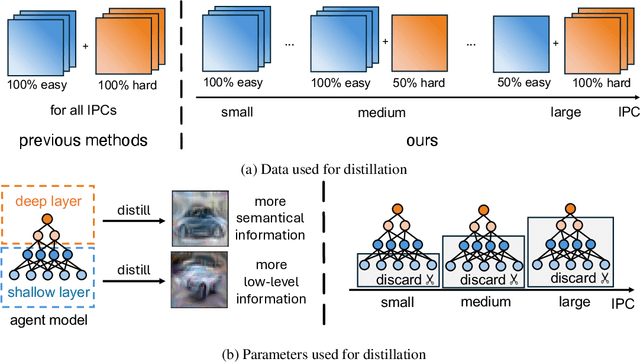
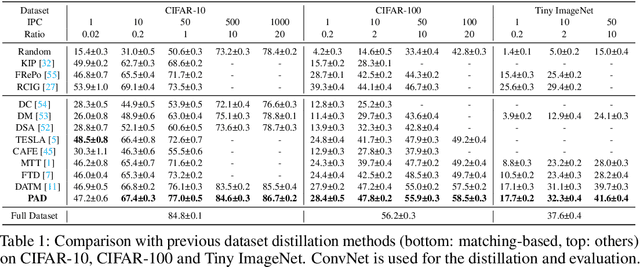
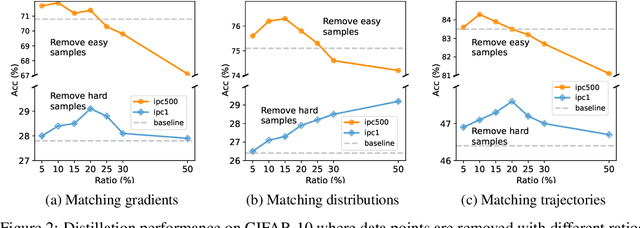
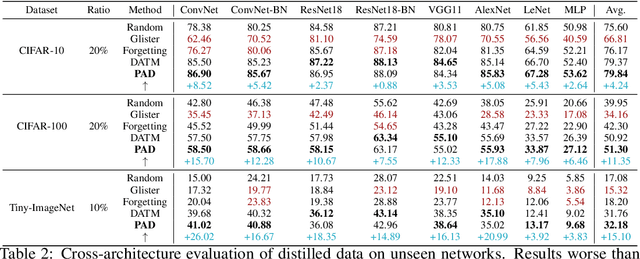
Abstract:Dataset Distillation aims to compress a large dataset into a significantly more compact, synthetic one without compromising the performance of the trained models. To achieve this, existing methods use the agent model to extract information from the target dataset and embed it into the distilled dataset. Consequently, the quality of extracted and embedded information determines the quality of the distilled dataset. In this work, we find that existing methods introduce misaligned information in both information extraction and embedding stages. To alleviate this, we propose Prioritize Alignment in Dataset Distillation (PAD), which aligns information from the following two perspectives. 1) We prune the target dataset according to the compressing ratio to filter the information that can be extracted by the agent model. 2) We use only deep layers of the agent model to perform the distillation to avoid excessively introducing low-level information. This simple strategy effectively filters out misaligned information and brings non-trivial improvement for mainstream matching-based distillation algorithms. Furthermore, built on trajectory matching, \textbf{PAD} achieves remarkable improvements on various benchmarks, achieving state-of-the-art performance.
Rethinking Human Evaluation Protocol for Text-to-Video Models: Enhancing Reliability,Reproducibility, and Practicality
Jun 13, 2024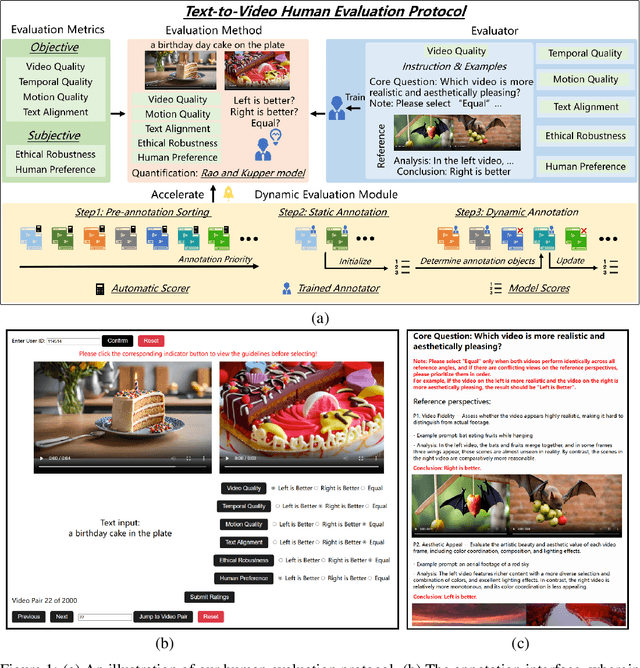
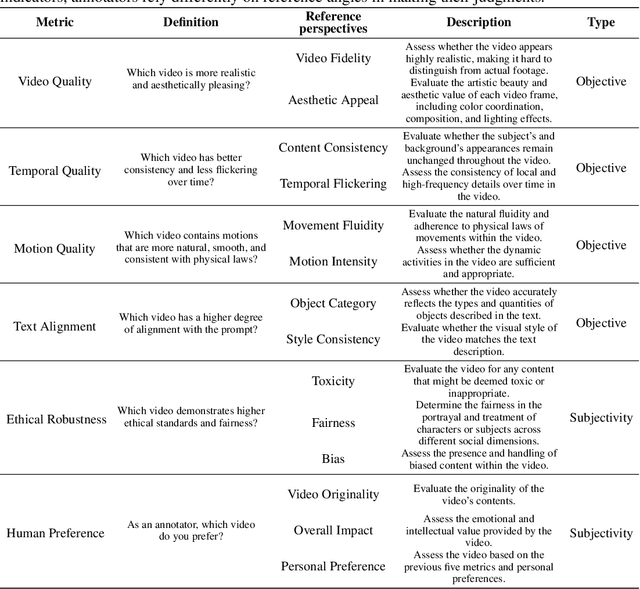


Abstract:Recent text-to-video (T2V) technology advancements, as demonstrated by models such as Gen2, Pika, and Sora, have significantly broadened its applicability and popularity. Despite these strides, evaluating these models poses substantial challenges. Primarily, due to the limitations inherent in automatic metrics, manual evaluation is often considered a superior method for assessing T2V generation. However, existing manual evaluation protocols face reproducibility, reliability, and practicality issues. To address these challenges, this paper introduces the Text-to-Video Human Evaluation (T2VHE) protocol, a comprehensive and standardized protocol for T2V models. The T2VHE protocol includes well-defined metrics, thorough annotator training, and an effective dynamic evaluation module. Experimental results demonstrate that this protocol not only ensures high-quality annotations but can also reduce evaluation costs by nearly 50%. We will open-source the entire setup of the T2VHE protocol, including the complete protocol workflow, the dynamic evaluation component details, and the annotation interface code. This will help communities establish more sophisticated human assessment protocols.
Continuous Geometry-Aware Graph Diffusion via Hyperbolic Neural PDE
Jun 03, 2024
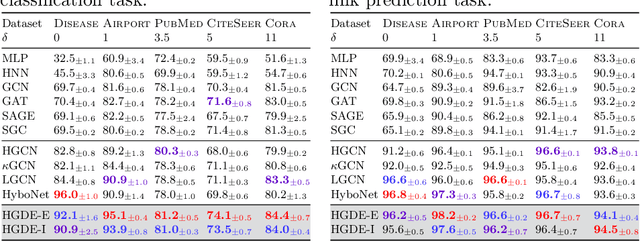

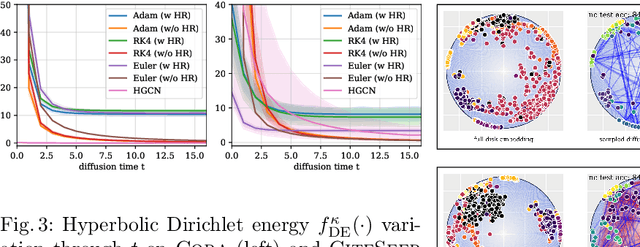
Abstract:While Hyperbolic Graph Neural Network (HGNN) has recently emerged as a powerful tool dealing with hierarchical graph data, the limitations of scalability and efficiency hinder itself from generalizing to deep models. In this paper, by envisioning depth as a continuous-time embedding evolution, we decouple the HGNN and reframe the information propagation as a partial differential equation, letting node-wise attention undertake the role of diffusivity within the Hyperbolic Neural PDE (HPDE). By introducing theoretical principles \textit{e.g.,} field and flow, gradient, divergence, and diffusivity on a non-Euclidean manifold for HPDE integration, we discuss both implicit and explicit discretization schemes to formulate numerical HPDE solvers. Further, we propose the Hyperbolic Graph Diffusion Equation (HGDE) -- a flexible vector flow function that can be integrated to obtain expressive hyperbolic node embeddings. By analyzing potential energy decay of embeddings, we demonstrate that HGDE is capable of modeling both low- and high-order proximity with the benefit of local-global diffusivity functions. Experiments on node classification and link prediction and image-text classification tasks verify the superiority of the proposed method, which consistently outperforms various competitive models by a significant margin.
 Add to Chrome
Add to Chrome Add to Firefox
Add to Firefox Add to Edge
Add to Edge